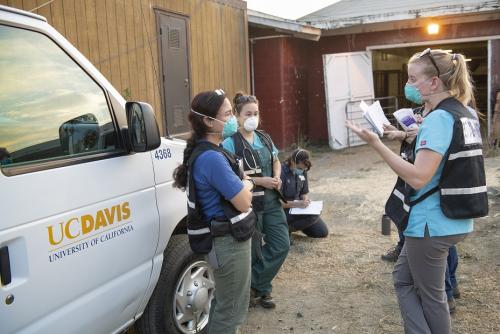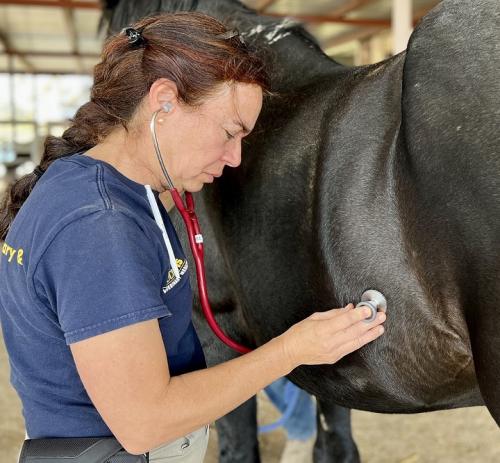From Tears to Cheers: The Realities of Working in Disaster Response

Dr. Lais Costa has seen it all. From tearful farewells to cheerful reunions, she is dedicated to making a difference in the face of natural disasters. Dr. Costa is the Director of Operations for the UC Davis Veterinary Emergency Response Team (VERT), a group of veterinarians, technicians, and students that provides veterinary care during disasters through Mutual Aid to northern California Counties. She graciously shared her experiences and thoughts about working in disaster response.
How did you get involved in this type of work?
My first experience was as an emergency veterinary clinician at Louisiana State University when Hurricane Katrina hit in 2005. The Lamar-Dixon Shelter had 500 horses. We were there from the beginning to the end, and I found the reunification of owners with their horses really rewarding.
In 2017, I was working at the UC Davis veterinary hospital when we treated horses from the Tubbs fire. That experience made me realize that veterinary professionals can really make a difference. After attending a recruitment seminar for VERT, I decided to join. In 2018, I participated in training on technical rescue, sheltering, and other topics. Additionally, I had the unique experience to train with the National Veterinary Response Teams, which are under the U.S. Department of Health and Human Services.
What is the Veterinary Emergency Response Team (VERT) and what is its role?
This year is the 25th anniversary of VERT! Professor Emeritus Dr. John Madigan founded VERT to respond to misfortunes of individual animals. As natural disasters changed in frequency and severity, VERT evolved in response. In particular, the 2018 Camp Fire made a mark in terms of how a local community can respond and care for animals during disasters.
What is the California Veterinary Emergency Team (CVET)?
CVET is a state resource administered by the UC Davis School of Veterinary Medicine in collaboration with the California Department of Food and Agriculture (CDFA), which is responsible for the California Animal Response Emergency System (CARES), and the California Governor’s Office of Emergency Services (Cal OES). Disaster responses start and end locally. State resources have to be requested when the situation progresses and overwhelms local resources. CVET will be deployed upon direct request from the agency having jurisdiction to assist and provide the veterinary support when local resources are about to be exhausted.
How can owners and communities make evacuations as easy as possible?
Permanent identification, microchips or tattoos, facilitates reunification of animals with their owners. Be sure to register microchips and update your information when there is a change of address or phone number!
Be prepared by knowing if you are in a high-risk fire zone and monitoring red flag days. Be ready to evacuate as soon as warnings are in place. Understand the hazards around you. Make sure your horse knows how to load easily in a trailer. Do evacuation drills with your horses so they get used to going through the motions in a non-emergency environment. Being prepared takes time and effort.
Have all records, medications, water and hay ready. Know your evacuation center options and the route to those locations. Plan alternative routes in case roads are closed. If you do not have a trailer, have a plan with someone who can help you. Find out what resources you have in your area, such as community animal response teams (CARTs).
What is the most important thing owners should know about horses and wildfires?
Be prepared. Horses read people faster than people read themselves. If the person is prepared, doesn’t panic and has a plan, the horse will cooperate. Look at the flaws in your plan and work through them until it becomes second nature. It is a low frequency, high-risk event. If you have the proper mindset, you won’t panic. Nothing can replace preparedness.

What research is important to our understanding of how to treat horses affected by natural disasters?
We do not think enough about chemical contamination, particularly with wildfires. When structures burn, contaminated ash gets on the skin and in the hair coat (horses groom themselves and each other with their teeth), and horses can ingest and inhale contaminated particles. We need to do more research to identify things that are harmful in these situations so we can have a decontamination plan for the animals and responders.
Where do you see this field going in the future?
I would like to see a focus on preparedness in all phases of disasters, before, during and after the incident. Preparation is essential to every stage. You have to be prepared to prevent the disaster in the first place. When it happens, you have to be prepared to protect the property and mitigate the impact of the fire. You have to be prepared to respond if the fire directly affects you and your property, and you have to be prepared to recover. You can’t predict, but you can prepare.
What keeps you going during the difficult situations?
The reward of helping animals and people in difficult times is priceless. Sometimes there are misfortunes and sadness, but we can learn from the situation and do better next time.
The other thing that keeps me going is the commitment of our students. They work hard. VERT gives them training and hands-on experience to make a difference. VERT currently has over 300 students!
Learn more about VERT at https://ohi.vetmed.ucdavis.edu/disaster-preparedness-response/vert.
